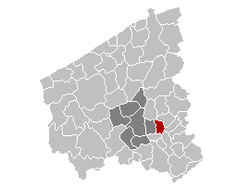Ingelmunster
| Ingelmunster | |||
|---|---|---|---|
| Municipality | |||

St-Amandus church besides the castle of Ingelmunster
|
|||
|
|||
| Location in Belgium | |||
|
Location of Ingelmunster in West Flanders
|
|||
| Coordinates: 50°55′N 03°15′E / 50.917°N 3.250°ECoordinates: 50°55′N 03°15′E / 50.917°N 3.250°E | |||
| Country | Belgium | ||
| Community | Flemish Community | ||
| Region | Flemish Region | ||
| Province | West Flanders | ||
| Arrondissement | Roeselare | ||
| Government | |||
| • Mayor | Kurt Windels (De Brug) | ||
| • Governing party/ies | De Brug, SP.A | ||
| Area | |||
| • Total | 16.16 km2 (6.24 sq mi) | ||
| Population (1 January 2016) | |||
| • Total | 10,792 | ||
| • Density | 670/km2 (1,700/sq mi) | ||
| Postal codes | 8770 | ||
| Area codes | 051 | ||
| Website | www.ingelmunster.be | ||
Ingelmunster is a municipality located in the Belgian province of West Flanders. The municipality comprises only the town of Ingelmunster proper and the village of Kriek. As of January 1, 2006, Ingelmunster had a total population of 10,617. Its total area is 16.16 km². Thus, its population density is 657 inhabitants per km².
The famous Flemish historian Sanderus mentioned Ingelmunster as "Anglo-Monasterium" ("English monastery"), but the name could also have originated from the term "Angle-Monastère" ("monastery on the corner"), as it was situated in the outskirts of the fiefdom.
It is said that Saint Amand ordered the locals to have a church built in the village, going so far as to plan a monastery. Additionally, Robrecht the Frisian thought of the village as a strategic point and considered it important enough to have a fortification built. The parish was transferred to the chapter of Harelbeke around 1200. In 1300, the castle and the fiefdom fell into the possession of the lords of Rode, from the region of Dendermonde.
In the Middle Ages, Ingelmunster was, partly owing to its fortification, an important location in the Castellany of Kortrijk and the canton of Harelbeke. The village fiefdom came under the rule of the lords of Gistel after the House of Rode. It then became part of Burgundy and Cleves, and ultimately subject to the French throne.
The most famous royal resident of the village was Philip the Fair, King of France, who resided in the castle in 1297, five years before the Battle of the Golden Spurs. At that time, Philip was on his way to punish Bruges. The people of Bruges met him halfway with an offer of submission to his rule, on the condition that they be allowed to keep the relic of the Holy Blood. The French king accepted.
...
Wikipedia




